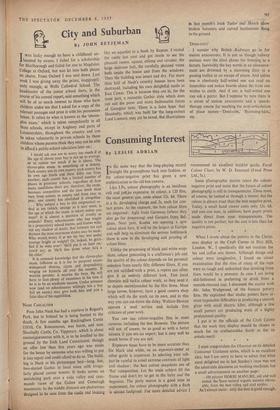Consuming Interest
By LESLIE ADRIAN TN the same way that the long-playing record 'brought the gramophone back into fashion, so the colour-negative print has given a new sophistication to the old box camera.
Like LPs, colour photography is an insidious cult and just;,a' s expensive. In colour, a 120 film, the most general size, costs about 12s. 8d. There is a 6s. developing charge .and 3s. each for con- tact prints. At the moment, the best colour films are imported : Agfa from Germany (where they also go for processing) and Gevaert from Bel- gium. Next year, Kodak are opening a new colour plant here. It will be the largest in Europe and will help to eliminate the serious bottleneck there is now in' the developing and printing of colour films.
" Unlike the processing of black and white snap- shots, colour processing is a craftsman's job and the quality of the colour depends on his personal selection from nearly fifty different filters. If you are not satisfied. with a print, a repeat can often give it an entirely different look. Few local chemists will tackle colour work, so they send it to depots recommended by the film firms. Most large towns, however, have a good camera shop which will do the work on its own, and in this way you can cut down the delay. Wallace Heaton operate a mail service and include free criticism of your work.
You can use colour-negative film in most cameras, including the box Brownie. The picture will not, of course, be as good as with a better camera if you are -an expert; but it may well be much better if you are not.
Exposure times have to be,more accurate than for. black and white, so an exposure-meter or other guide is important. In selecting your sub- ject be careful to avoid extreme contrasts of light and shadow : the best colour snapshots are of 'flat' composition. Let the main subject fill the frame and don't try to get in the baby and 'the begonias. The party season is a good time to experiment, for colour photography with a flash is almost foolproof. For more detailed advice I recommend an excellent booklet guide, Focal Colour Chart, by W. D. Emanuel (Focal Press. Ltd., 5s.).
Some photographic purists reject the colour- negative print and insist that the future of colour photography is still in transparencies. These must, of course, be looked at through a viewer, but the colour is always truer than the best negative print. Today, a small hand viewer costs only 12s. 6d. and you can now, in addition, have paper prints made direct from your transparencies. The quality is not perfect, but the cost is less than for negative prints.
*
When I wrote about the pottery in the Christ- mas display at the Craft Centre in Hay Hill, London, W., I specifically did not mention the tea and coffee sets shown. Although design and colour were imaginative, I found on closer examination that the rims of many of the cups were so rough and unfinished that drinking from them would be a penance. In case I am being old-fashioned in preferring to drink from a smooth-rimmed cup, I discussed the matter with -Mr. John Wedgwood, of the famous pottery firm. He explained that studio potters have al- most impossible difficulties in producing a smooth glaze with small electric kilns, although a few small potters are producing work of a highly professional quality.
I put it to the officials of the Craft Centre that the work they display should be chosen as much for its craftsmanlike finish as for its artistic merit.
I must congratulate the Observer on its detailed Consumer Guidance series, which is an excellent idea; but I am sorry to have to admit that what most delighted me in last Sunday's issue was not the admirable discourse on washing machines, but a small advertisement on another page :
• 100 pe'rcent HORSE MANURE, old and well rotted, the 'finest natural organic manure obtain- able, from the best riding and stud stables. . . . As I always insist : only the best is good enough.














































 Previous page
Previous page